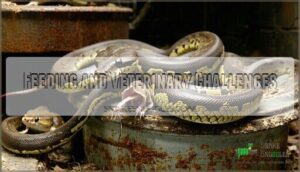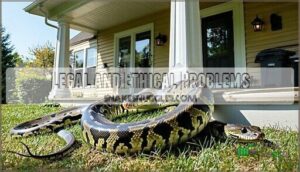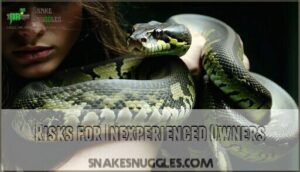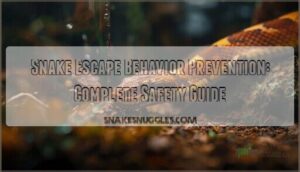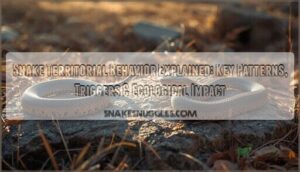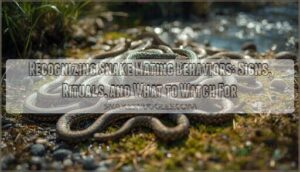This site is supported by our readers. We may earn a commission, at no cost to you, if you purchase through links.

Reticulated pythons exceeding 20 feet, 200-pound Burmese pythons, 550-pound green anacondas, aggressive African rock pythons, and unpredictable boa constrictors attract three types of owners: experienced herpetologists seeking the ultimate challenge, collectors wanting impressive status symbols, and thrill-seekers drawn to apex predators.
These species demand massive enclosures, cost thousands annually, offer zero affection, and carry genuine safety risks.
Most owners surrender them within two years, yet some persist despite legal restrictions and insurance nightmares.
What drives people to choose these living nightmares reveals fascinating insights about human psychology.
Table Of Contents
- Key Takeaways
- The Largest Pet Snakes to Avoid
- Dangers and Behavioral Risks
- Enclosure, Space, and Care Demands
- Legal and Ethical Problems
- Why Large Snakes Make Terrible Pets
- Frequently Asked Questions (FAQs)
- What is the best big snake to own?
- What is the biggest friendliest snake?
- What is the most docile snake species?
- What is the most tame pet snake?
- How often do large snakes need to eat?
- Whats the lifespan of a typical large snake?
- How much space does a large snake require?
- Are large snakes legal to keep as pets?
- What should I know before getting a large snake?
- What happens when large snakes outgrow their owners?
- Conclusion
Key Takeaways
- You’ll face crushing financial obligations with annual costs exceeding $2,000 just for housing upgrades, plus expensive veterinary bills and massive prey costs that make these snakes budget destroyers rather than pets.
- You’re risking serious injury and legal nightmares since these giants can escape easily, attack unpredictably, and many species are banned or heavily regulated under federal and state laws with hefty penalties.
- You won’t get any emotional reward since large snakes don’t bond with owners, show affection, or recognize you – they’re essentially living decorations that view you only as a heat source.
- You’ll likely abandon your snake within two years like most owners do, contributing to ecological disasters when these invasive species escape and devastate local wildlife populations.
The Largest Pet Snakes to Avoid
In the case of giant pet snakes, you’ll find their size alone brings challenges most owners aren’t ready for.
You might dream of a “showpiece” reptile, but these species can outgrow your expectations—and your living room—faster than you think, which is a challenge related to their size.
That trophy python you’re dreaming about will quickly become your worst nightmare when it outgrows every corner of your home
Reticulated Pythons
If you’re interested in power and control, reticulated pythons will definitely test your limits.
These large pet snakes have intense reticulated behavior and strict python care needs.
Here’s what you’re signing up for:
- Python habitat upgrades every few years
- Challenging snake feeding routines
- Powerful bites if stressed
- Daily monitoring, not “set and forget” pet ownership
Burmese Pythons
If you thought Reticulated Pythons were a handful, Burmese Pythons take things up a notch.
These large pet snakes can overwhelm even seasoned keepers with their impressive size and strong python behavior.
Burmese Pythons often struggle with feeding challenges and are infamous for causing habitat destruction, invasive species issues, and new snake ownership laws.
Exotic pet care gets complicated—fast.
Green Anacondas
Green Anacondas aren’t house guests—you’re inviting a heavyweight champ with appetite and attitude.
Their habitat needs stretch beyond a standard tank, demanding constant water access. Trouble starts with snake handling, as even experts find these large species unpredictable.
- Feeding issues: giant meals and long fasts
- Anaconda care: complex and costly
- Wildlife regulations: restrictions everywhere
African Rock Pythons
If you thought anacondas are tough, meet the African Rock Python—nature’s sledgehammer.
This snake dwarfs most Ball Pythons and even challenges Burmese Pythons in terms of size and unpredictability.
Keeping one is like owning a loaded spring; their aggressive python behavior and huge enclosure demands put pet safety at constant risk.
| Trait | Detail | Caution |
|---|---|---|
| Habitat | Varied Africa | Secure Lids |
| Feeding | Eats Large | Handle Sparingly |
| Size | Up to 20+ ft | Not for Homes |
Boa Constrictors
A boa constrictor might look tame compared to anacondas, Burmese pythons, or reticulated pythons, but don’t let that fool you.
These constrictor snakes can reach up to thirteen feet.
Boa behavior is often mellow, but size matters—proper boa care, safe pet handling, thoughtful constrictor habitat, and expert snake feeding are nonnegotiable if you want real control.
Dangers and Behavioral Risks
When you keep a giant snake, you’re not just getting a pet—you’re accepting daily risks that can startle even seasoned owners.
Their unpredictable behaviors, powerful bodies, and escape habits make safety and control a constant challenge.
Aggression and Unpredictable Temperaments
Even the calmest Ball Python can surprise you with wild temperaments and unpredictable reptile behavior.
You’ll face real pet dangers—some snakes strike first, ask questions later.
Watch out for:
- Sudden Snake Attacks when least expected
- Aggressive Species like anacondas or reticulated pythons
- Mood swings in boa constrictors
- Burmese Pythons’ unpredictable responses during handling
The reticulated python’s wild habitat needs are often overlooked by inexperienced owners, leading to unpredictable behavior.
Size and Strength Hazards
Massive pythons pack crushing power that’ll make you rethink keeping them.
Burmese Pythons exceed 200 pounds, while Green Anacondas reach 550 pounds of pure muscle.
Their Strength Risks include bursting standard enclosures and overwhelming handlers during feeding.
These giants demand Large Enclosures over 100 square feet, with Space Demands that most homes can’t accommodate.
Boa Constrictors may seem smaller, but their Crushing Power can suffocate large animals.
Snake Attacks often result from underestimating their raw physical capabilities and inadequate Snake Care protocols.
Escape and Containment Issues
Beyond sheer size, these giants present nightmare scenarios when they slip their bonds. You’ll face sleepless nights knowing your "pet" could be exploring your neighbor’s attic or local playground.
- Snake Escapes happen frequently with large species due to their incredible strength and problem-solving abilities
- Enclosure Design failures occur when glass tanks shatter under pressure from 200+ pound constrictors
- Containment Risks multiply in rental properties where Anacondas and Boa Constrictors can access shared spaces
- Secure Housing costs thousands annually, requiring reinforced materials and professional-grade locks for Reptile Keeping
- Escape Prevention becomes impossible when these Injurious Wildlife species outgrow even custom-built enclosures within years
Proper boa enclosure size guidelines can be found at reptile care websites.
Emergency Incidents and Attacks
Large snakes’ emergency incidents have sparked nationwide alerts when they’ve escaped urban homes.
You’ll find documented cases where reticulated pythons attacked handlers during routine feeding, requiring emergency response teams.
Fatal incidents involving anacondas and boa constrictors highlight serious pet risks.
These injurious wildlife species, regulated under the Lacey Act, pose genuine threats that can overwhelm first responders unprepared for such dangerous encounters.
Understanding boa constrictor behavior is essential to preventing such attacks and ensuring public safety.
Enclosure, Space, and Care Demands
You’ll quickly discover that keeping these massive serpents demands far more than a simple terrarium and weekly feeding schedule.
The housing requirements alone will consume entire rooms of your home, while the specialized care needs often exceed what most reptile veterinarians can provide, which involves massive efforts.
Specialized Housing Requirements
You’ll need specialized enclosures exceeding 100 square feet for species over 15 feet.
Reticulated and Burmese pythons can burst standard glass tanks, requiring reinforced barriers.
Annual maintenance costs often surpass $2,000 due to necessary structure upgrades.
Anacondas need regular water access, making standard terrariums impractical.
Proper enclosure design demands serious investment and expertise.
For large snakes, proper snake enclosure design is essential to their health and safety.
Replicating Natural Habitats
Creating authentic habitats for these massive serpents demands extraordinary Environmental Control and Climate Simulation expertise.
You’ll struggle with Terrarium Plants that survive anaconda humidity or python heat requirements. Habitat Design becomes nightmarish when replicating Southeast Asian rainforests or South American wetlands.
Ecosystem Balance proves nearly impossible in captivity, even with captive-bred specimens requiring specialized Snake Husbandry knowledge far beyond typical Ball Python Care or standard Pet Snake Species management in Reptile Keeping.
Proper Reptile Enclosures require careful planning and execution to guarantee the health and well-being of the snakes, involving reptile enclosure design considerations.
Feeding and Veterinary Challenges
You’ll struggle with feeding massive snakes requiring rabbits or chickens, which are expensive and hard to source regularly.
Veterinary care becomes nearly impossible since few vets handle giant constrictors, and transport alone poses serious risks.
Diet problems like regurgitation and obesity are common, while health risks from respiratory infections affect up to 38% of Burmese pythons in captivity.
Proper reptile care habits are essential to mitigate these issues and guarantee the well-being of the snakes.
High Maintenance Costs
Beyond veterinary bills, you’re looking at serious cash flow challenges.
Annual maintenance costs for large snake housing often surpass $2,000 due to structure upgrades. Snake keepers discover that captivebred giants demand substantially more resources than beginner-friendly alternatives like rat snakes or king snakes.
Properly designed large snake enclosures are essential for maintaining a safe environment.
Your wallet takes multiple hits through:
- Feeding Expenses – Large prey items cost exponentially more than pink mice for smaller pet snakes
- Housing Upgrades – Reinforced enclosures and climate control systems require constant investment
- Veterinary Costs – Care specialists charge premium rates for exotic species expertise
- Escape Prevention – Security modifications and monitoring equipment add unexpected expenses
Legal and Ethical Problems
Even if you think you’re prepared for a massive snake, you’re probably breaking multiple laws and facing serious ethical dilemmas.
Your homeowner’s insurance will likely drop you, and you’ll contribute to environmental problems that affect entire ecosystems.
Ownership Laws and Restrictions
You’ll face a regulatory maze when considering large snake ownership.
The Lacey Act classifies many giants as Injurious Wildlife, banning interstate transport of reticulated pythons, Burmese pythons, and green anacondas.
Species Bans vary by state – Florida prohibits private ownership entirely, while Texas demands Permit Requirements and liability insurance for pythons over six feet.
Local Enforcement Measures often exceed state laws, creating additional Legal Restrictions that can result in hefty fines and animal forfeiture, which are part of the regulatory maze and involve Injurious Wildlife.
Impact on Local Ecosystems
Large reptile pets create environmental disasters when they escape or get released into wild habitats.
These invasive species devastate native wildlife populations through predation and competition.
- Burmese pythons eliminated 99% of raccoons and opossums in Florida’s Everglades
- Ecosystem disruption occurs as these predators outcompete bobcats and panthers for prey
- Habitat destruction follows when invasive species alter food webs and biodiversity loss accelerates
The Lacey Act restricts injurious wildlife transport, but garter snakes and other native species continue suffering from irresponsible snake breeding practices, which lead to invasive species issues.
Insurance and Liability Issues
Your homeowner’s insurance won’t cover you when your twenty-foot python escapes and terrorizes the neighborhood.
Most policies exclude reptile pets through specific policy exclusions, leaving you facing massive liability claims alone.
Insurance costs skyrocket when companies discover your giant snake collection during risk assessment.
The financial burden becomes crushing when lawsuits pile up, making even harmless rosy boa and garter snakes seem appealing alternatives to these legal nightmares.
The situation is further complicated by the fact that insurance policies often have specific policy exclusions that leave owners of exotic pets like giant snakes vulnerable to significant financial risks.
Overcollection and Captive Breeding Ethics
Wildlife collectors drain natural populations when they target rare morphs, threatening species like Rosy Boa and Garter Snakes.
The Pet Trade’s demand fuels this cycle, while captive Breeding Ethics remain questionable. You’ll find most operations prioritize profit over Animal Welfare.
Sustainable Practices require supporting legitimate breeders who follow Wildlife Conservation guidelines and comply with Lacey Act regulations.
Responsible owners should research and understand ethical breeding practices to make informed decisions about pet snake care.
Why Large Snakes Make Terrible Pets
You’re looking at pets that demand decades of commitment and thousands of dollars in specialized care, yet they’ll never recognize you or show affection like traditional companions.
These massive serpents create stress for both owner and animal, with mortality rates exceeding 20% in the first two years due to the complex requirements that most people simply can’t meet.
Lack of Bonding or Affection
Everyone craves emotional connection with pets, but large snakes won’t reciprocate your affection like smaller species such as Rosy Boa or Garter Snakes do.
These giants lack animal affinity mechanisms for owner bonding, making snake handling feel mechanical rather than rewarding.
Pet attachment simply doesn’t develop when your "companion" views you solely as a heat source, not a partner.
Long-Term Commitment and Lifespan
You’re looking at decades of commitment when choosing large snakes.
Snake Lifespan for species like reticulated pythons can exceed 30 years, demanding consistent Long Term Care throughout multiple life stages.
Pet Ownership involves ongoing Veterinary Needs, specialized equipment upgrades, and Breeding Challenges if reproduction occurs.
Unlike Rosy Boa or Garter Snakes that mature quickly, giant species require years to reach adult size.
High Mortality and Stress Rates
Large snakes face alarmingly high Mortality Factors that should make any potential owner reconsider.
Looking at mortality rates exceeding 20% in their first two years? That’s your wake-up call right there
Unlike hardy Rosy Boa or resilient Garter Snakes, these giants suffer from serious Stress Causes and Veterinary Issues that create overwhelming Care Challenges affecting Snake Health.
Consider these sobering statistics:
- 1.9% die within their first year despite dedicated owner care
- 20% mortality rate occurs in the first two years from husbandry mistakes
- Inclusion body disease kills pythons within days or weeks of symptom onset
- Chronic stress compromises immune systems, leading to organ dysfunction and death
Risks for Inexperienced Owners
Without proper training, you’ll quickly find yourself overwhelmed when snake bites occur or emergency response becomes critical.
Inexperienced owners often skip essential pet insurance and struggle to locate qualified veterinary care for giants.
Unlike manageable species such as rosy boa, large constrictors demand expert-level owner safety protocols that beginners simply can’t master overnight.
Understanding snake health and safety guide principles is vital for preventing accidents and ensuring the well-being of both humans and pets, especially when dealing with snake bite prevention methods.
Frequently Asked Questions (FAQs)
What is the best big snake to own?
Boa constrictors represent your best option for large snake ownership.
They’re manageable at 8-13 feet, have mellow temperaments, aren’t restricted by federal law, and don’t require the extreme space demands of reticulated or Burmese pythons.
What is the biggest friendliest snake?
Among large constrictors, you’ll find boa constrictors offer the best combination of impressive size and manageable temperament.
They typically reach 8-13 feet while maintaining relatively calm dispositions compared to other giants.
What is the most docile snake species?
Ironically, you’ll find the most docile snakes aren’t always the smallest ones.
Ball pythons top the list for mellow temperament, rarely biting and curling defensively instead.
Corn snakes and rosy boas also make excellent calm companions.
What is the most tame pet snake?
Ball pythons stand out as the most tame pet snakes.
They’re naturally calm, rarely bite, and handle stress well.
You’ll find them docile enough for beginners yet rewarding for experienced keepers, as they are naturally calm.
How often do large snakes need to eat?
Large snakes eat every 1-4 weeks depending on size, age, and species. You’ll feed juveniles more frequently than adults, with massive pythons sometimes going months between meals during cooler periods.
Whats the lifespan of a typical large snake?
Large snakes typically live 20-30 years in captivity, with proper care extending their lifespan substantially.
You’ll find species like ball pythons and boas can exceed three decades when you maintain ideal conditions.
How much space does a large snake require?
Don’t bite off more than you can chew – large snakes need massive space. Species over 15 feet require specialized enclosures exceeding 100 square feet for minimal welfare standards, costing thousands annually.
Are large snakes legal to keep as pets?
You’ll check state and local laws since they vary widely. Federal law doesn’t prohibit most large snake species, but state regulations create a complex patchwork of restrictions across different communities.
What should I know before getting a large snake?
Like Pandora’s box, large snakes trigger complications you can’t undo.
You’ll need specialized enclosures, veterinary expertise, permits, insurance considerations, and decades-long commitment.
Most species require 100+ square feet of space and cost thousands annually in proper care.
What happens when large snakes outgrow their owners?
When you can’t handle your snake’s size, you’ll face abandonment, surrender to rescues, or expensive rehoming. Many owners underestimate lifelong commitment, leading to escaped snakes threatening ecosystems.
Conclusion
Don’t bite off more than you can chew when considering terrible large pet snake species who’d want these massive reptiles.
While experienced herpetologists and collectors might find appeal in these giants, the reality involves substantial risks, legal complications, and crushing financial obligations.
These snakes don’t offer companionship, frequently escape their enclosures, and can seriously injure handlers.
Most owners quickly realize they’ve made a costly mistake, abandoning their dangerous pets within two years of purchase.




